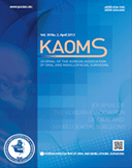Journal of the Korean Association of Oral and Maxillofacial Surgeons
- P-ISSN2234-7550
- E-ISSN2234-5930
- SCOPUS, KCI, ESCI
 ISSN : 2234-7550
ISSN : 2234-7550
Overall and disease-specific survival outcomes following primary surgery for oral squamous cell carcinoma: analysis of consecutive 67 patients
황종현 (울산대학교)
안강민 (울산대학교)
Abstract
Objectives: This study evaluated the predictive factors for survival of patients with oral squamous cell carcinoma (OSCC) and investigated the overall and disease-specific survival (DSS) outcomes. Materials and Methods: A total of 67 consecutive patients who underwent surgery for OSCC from January 2006 to November 2014 were included in this study. Patients were classified according to age, sex, pTNM stages, primary sites, smoking and alcohol drinking habits, depth of invasion, perineural and lymphovascular invasion, cell differentiation and postoperative radiotherapy. Kaplan–Meier methods were used to estimate the survival categorized by patient groups. Cox regression methods were used to investigate the main independent predictors of survival. Results: Nineteen patients died of OSCC during follow-up periods. Another five patients died of other diseases including lung adenocarcinoma (n=1), cerebral infarction (n=1), general weakness (n=2), and pneumonia (n=1). The tongue (n=16) was the most common site for primary origin, followed by buccal mucosa (n=15), mandibular gingiva (n=15), maxillary gingiva (n=9), floor of mouth (n=9), retromolar trigone (n=2), and palate (n=1). Eleven patients had pTNM stage I disease, followed by stage II (n=22) and stage IV (n=34). No patients had pTNM stage III disease in this study. The overall survival of all patients was 64.2% and the DSS was 71.6%. DSS of patients with stage I and II disease was 100%. Stepwise Cox regression showed the two predictors for DSS were pTNM stage (P<0.0001, odds ratio=19.633) and presence of metastatic lymph nodes (P=0.0004, odds ratio=0.1039). Conclusion: OSCC has been associated with poor prognosis; however, there were improved survival outcomes compared with past studies. Advanced-stage disease and presence of metastatic lymph nodes were associated with poorer survival compared with early-stage OSCC and absence of neck node metastasis. Stage I and II OSCC were associated with excellent survival results in this study.
- keywords
- Head and neck neoplasm, Survival, Lymphatic metastasis, Neoplasm staging
- 다운로드 수
- 조회수
- 0KCI 피인용수
- 0WOS 피인용수